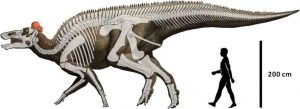
The duck-billed dinosaurs (hadrosaurs) may not be as glamorous as tyrannosaurs (and most tyrannosaur researchers sure don’t respect these “Cretaceous food items” anyhow), but in many ways they are a far more interesting and scientifically viable group to study. Hadrosaurs are known from literally tons of fossils from around the world, often with nearly complete skeletons and frequent soft-tissue preservation. As a result, you can answer a lot of research questions with hadrosaurs that are difficult to address with more rare groups. But, surprisingly (or perhaps not surprisingly, given many people’s inexplicable preference for the sharp-in-tooth-and-claw tyrannosaurs), lots of basic research on hadrosaurs remains. This is a golden opportunity for scientists!
In many ways, Edmontosaurus is the archetype of hadrosaurs. Their fossils, abundant in North American rocks from around 72 to 66 million years old, are on display in numerous museums and have consequently been featured in toys and on television alike. Early researchers, beginning in the first half of the 20th century, lavishly described and illustrated many of these specimens in the scientific literature. Yet, that grand tradition of detailed description has fallen somewhat fallow. We as scientists are often happy to rest on the laurels of our predecessors. If Edmontosaurus was already well-described back in 1920, what’s the point in doing it again?
As paleontologists learn more about the anatomy and evolution of hadrosaurs, it’s readily apparent that earlier workers didn’t even know to bother describing, comparing, and illustrating certain features. This is not their fault, of course–different aspects of anatomy are considered more relevant at different times. As additional species are uncovered or as old species are invalidated, the importance of some anatomical details is elevated, and that of other details is decreased. So, it never hurts to revisit “old” and well-described fossils.
A new paper by Hai Xing and colleagues redescribes skulls of the original Edmontosaurus species, Edmontosaurus regalis. Uncovered in Upper Cretaceous rocks of Alberta, over a dozen pretty decent crania, partial skeletons, and many fragments are known. Edmontosaurus as a genus was recently revised, showing that many things previously lumped into various species and genera (including the old classics Anatosaurus and Anatotitan) were likely just two species of Edmontosaurus: E. regalis (the earlier Canadian form) and E. annectens (the later form found in both Canada and the United States). An Alaskan form, Ugrunaaluk, was considered to be closely related. So, with all of the family tree stuff sorted out, now is a good time to review the variation within Edmontosaurus regalis and describe some newly relevant (and previously unrecognized) anatomical details.
The paper, published last week in PLOS ONE, provides detailed illustrations and text descriptions for numerous details on the skull in Edmontosaurus regalis. Once the anatomical work was out of the way, the authors re-evaluated previously proposed differences with the sister species E. annectens, and were able to add several formerly unrecognized features that can help separate the two species. Next, a comprehensive analysis produced a new family tree, which was broadly similar to previously published versions but also had a few interesting adjustments. For instance, an animal from Alabama called Eotrachodon was found to fall outside of the main group of “true” hadrosaurids (rather than within the group as previously proposed). A number of other slight readjustments also appeared in the analysis, all of which have relevance for how hadrosaurs spread across the surface of the globe during their evolution.
Finally, restudy of Edmontosaurus regalis indicates a potential shake-up for the Alaskan duck-bill Ugrunaaluk. Ugrunaaluk is known from numerous specimens, but they are all juveniles. Xing and colleagues note many similarities between Ugrunaaluk and Edmontosaurus regalis–enough that they may even be the same species. Frustratingly, though, no juveniles of E. regalis are known at a size similar to those for Ugrunaaluk, meaning that equivalent life stages from the animals can’t be compared directly. So, we’re back to the classic refrain: we need more fossils to know for sure!
Reference:
- Hai Xing et al. Supplementary cranial description of the types of Edmontosaurus regalis (Ornithischia: Hadrosauridae), with comments on the phylogenetics and biogeography of Hadrosaurinae, PLOS ONE (2017). DOI: 10.1371/journal.pone.0175253
- Nicolás E. Campione et al. Cranial Growth and Variation in Edmontosaurs (Dinosauria: Hadrosauridae): Implications for Latest Cretaceous Megaherbivore Diversity in North America, PLoS ONE (2011). DOI: 10.1371/journal.pone.0025186
Note: The above post is reprinted from materials provided by Public Library of Science. This story is republished courtesy of PLOS Blogs: blogs.plos.org.










